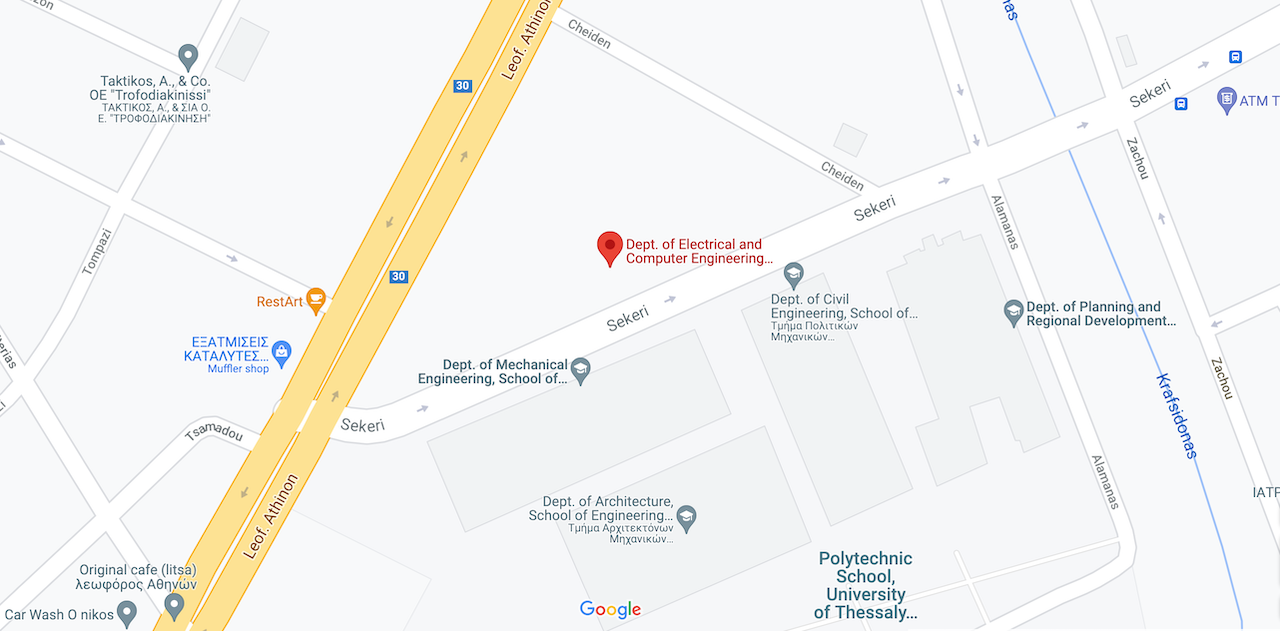| Subject Area | Computer Hardware and Architecture |
|---|---|
| Semester | Semester 5 – Fall |
| Type | Elective |
| Teaching Hours | 4 |
| ECTS | 6 |
| Recommended Courses | |
| Course Site | https://eclass.uth.gr/courses/E-CE_U_142/ |
| Course Director |
|
| Course Instructor |
|
- Revision of Digital Logic Fundamentals
Binary Arithmetic, Digital Logic, Electrical Characteristics of Circuits
Boolean Algebra, Combinational and Sequential Gates
Flip-Flops and Latches, and their operation
Finite State Machines
Circuit Types - Electronic Design Automation Flows
EDA Flow Steps
Hierarchical Design
Abstraction Layers – Hardware Description Languages - The Verilog Hardware Description Language
Verilog particulars, Verilog Representation and Implementation
Modules, Instances, Syntax and Time in Verilog
Primitives, Modeling Styles, Language Conventions
Number Representation, Operators, Variables and Types
Assignments, Ports, Busses
if/else, case statements, Synthesisability, Functional Test
Sensitivity Lists, initial/always Blocks, Wire Assignments
for/while loops, Parameters, Memory, Functions and Tasks
Events, Delays, Dependencies between Parallel blocks
Synthesisable Structures and Circuit Mapping
Flip-Flops, Counters, Accumulators, Shifters, Multiplexers
Encoders, Decoders, Adders, Comparators
Edge Detector, D Latch, Synchronous/Asynchronous Memory
FSM Descriptions in Verilog - Arithmetic Circuits
Half and Full Adder, Ripple-Carry Adder
Look-Ahead Carry Adder, Carry Computation and Hierarchy
Multiplication Algorithm, Shift and Add Multiplier
Lookup Table Multiplier, Partial product Multiplier
Division Algorithm, Comparison, Shift and Subtract - Synchronisation and Metastability
Synchronisation Scenarios, Vo/Vi Characteristic and Mechanical Equivalent
2 FF Synchronisation, Metastability
Metastability Probability, Mean Time between Failures
Synchronisation using Handshake Protocol or FIFO - Finite State Machines
FSM Specification, Flow Table, State Graph
Mealy/Moore FSMs, Encoding, Implementing FSMs using Binary Logic
Initialisation, Determinism, Don’t Cares
Interacting FSMs, Multiple FSM Composition
Equivalent States, K-distinguishable and K-equivalent states
State Minimisation for Fully-Specified FSMs, Minimisation with DCs - Boolean Algebra, Boolean Optimisation
Function Representation on the Binary Cube
Boole/Shannon Expansion, Canonical Forms, Minterms/Maxterms
Consensus, Implication, the SAT problem, SDCs/ODCs
Tautology, Implicants and Prime Implicants
Essential Implicants, Quine/McCluskey Theorem
Primes Computation using Tabular Method, the Unate Covering Problem
Minimisation with Don’t Cares, Multiple Output Functions - Timing, Stating Timing Analysis
Combinational Gate Delay, Sequential Gate Delay, Setup and Hold Constraints
Synchronous Circuit Model – Path Types, Static Timing Analysis
Minimum Period, Hold Violations, Clock Tree Design
Clock Gating
The goals of HY430, “Digital Systems Lab”, include (1) gaining an understanding in the theoretical fundamentals of Digital System design, (2) getting accustomed to practical design and implementation methodologies, particularly focusing on programmable logic and FPGAs (Field Programmable Gate Arrays) and the Verilog Hardware Description Language, and (3) the combination of theory and practice in implementing and testing useful and practical circuits in the laboratory, where students use cutting edge FPGA development boards.
The course focuses on providing equilibrium between theoretical knowledge and hands-on practice for the design of realistic digital circuits of small or medium size. Thus, in combination with the necessary presented theoretical background in digital design, which includes: (a) Boolean algebra fundamentals, basic gates, number representation, Boolean algebra Axioms and Identities, (b) combinational circuits, representation and analysis, 2-level and multi-level implementation, Area-Delay Pareto curve, (c) Sequential circuits, registers, latches, analysis of circuits with feedback, (d) SRAM/DRAM memories, (e) busses, (f) timing and synchronization of digital circuits, the theory background is combined state of the art FPGA implementation flows and the Verilog Hardware Description Language. State of the art FPGA boards, in conjunction with the appropriate EDA (Electronic Design Automation) software are presented and used, not only for simulation, but also for implementation in the course laboratory, where lab assignments are implemented on the FPGA devices and tested.
Upon successful completion of the course, the student will possess the following understanding and skill set:
- Knowledge and Understanding of the theory of Digital Systems Design
- Knowledge and Understanding of practical, commercial EDA tools for FPGA design
- Understanding of the methodology for describing circuits in Verilog HDL for synthesizability by EDA tools
- Extensive Practice on the theory and the implementation methodology from the completion of the 4 Labs of the course, by implementing a set of practical digital circuits as well as testing them. For the successful completion of the labs, analysis of the circuit specifications is required, synthesis of the required subcomponents, as well as quantification of the optimal synthesis
- Knowledge of writing up Technical Manuals describing their circuit implementations, which describe the design, verification and test process.







